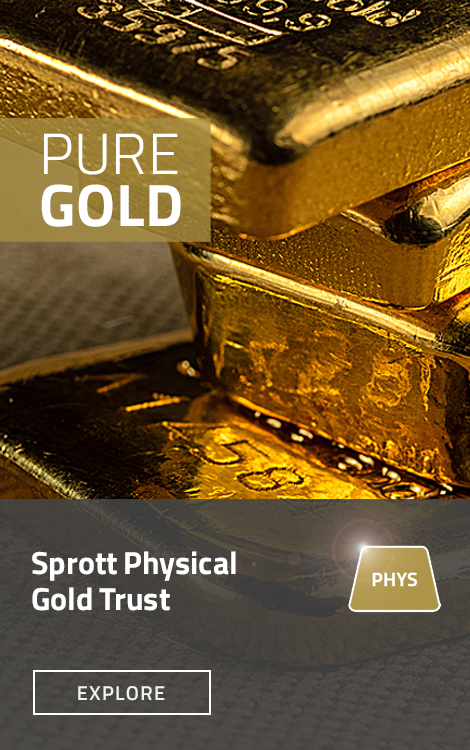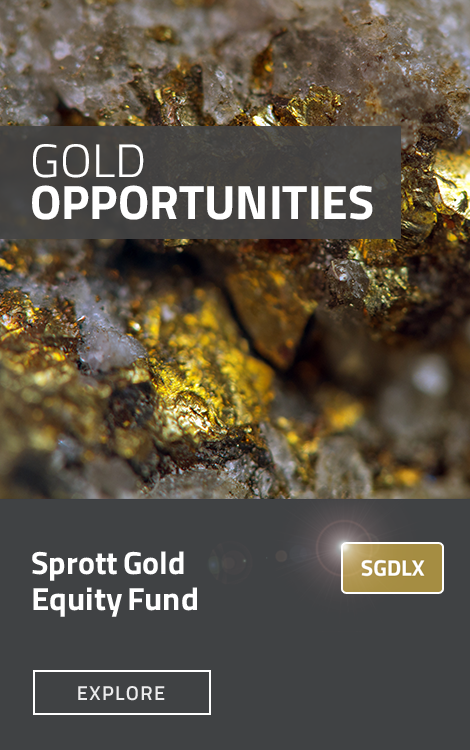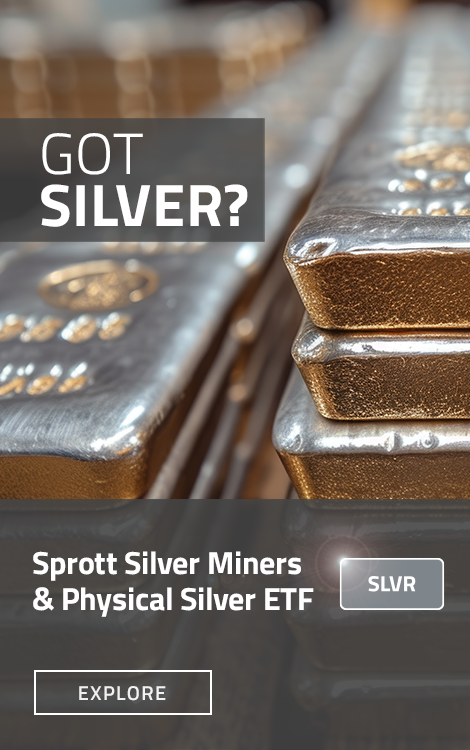Sprott Precious Metals Watch
Please see the bottom of this page for Investment Risks and other Important Disclosure.
Featured
Central banks are increasingly buying gold from local mines as prices surge
Central banks around the world are increasingly purchasing gold directly from domestic mines to cut costs, support local industries, and strengthen reserves amid record-high prices. This shift allows them to use local currencies instead of depleting foreign exchange reserves, with countries like Ghana, Tanzania, and the Philippines leading the trend. While the practice raises concerns about sourcing from artisanal miners, experts say central banks can help formalize and improve the supply chain.
Silver Might Be Benefiting From Russian Central Bank Buying
Russia’s central bank may be quietly accumulating silver, contributing to the metal’s 14-year price high and outperforming gold in recent months. This move marks a strategic shift, as silver—long overshadowed by gold—is now seen as a potential tool for BRIC nations to reduce reliance on the U.S. dollar. Rising industrial demand and silver’s affordability compared to gold are further boosting its appeal to investors and governments alike.
Gold and Silver Bull Run Continues
Paul Wong, CFA, Market Strategist: Gold and silver have been strong performers in 2025, with both metals up over 25% YTD as global instability drives demand for safe haven assets. Central banks are shifting away from the U.S. dollar, while silver’s breakout suggests a potential supply squeeze ahead.
Gold Is Near an All-Time High—Here’s How Much a Costco Bar Bought a Year Ago Is Worth Today
A 1-ounce gold bar purchased at Costco in June 2024 for $2,399.99 would be worth about $3,390 today—a 41.3% gain—thanks to a surge in gold prices amid geopolitical and economic uncertainty. However, selling the bar comes with caveats, including dealer markdowns, potential scams, and capital gains taxes as high as 28%.
Platinum price surges to highest in four years as market tightens
Platinum prices have surged to their highest level since May 2021, reaching $1,200.95 per ounce, as market tightness continues. Analysts attribute the rally to supply constraints, strong industrial demand, and technical momentum from the broader precious metals market. The World Platinum Investment Council projects a near one-million-ounce supply deficit for 2025, further supporting bullish sentiment.
Gold Gains Ground as Faith in the Dollar Erodes
Paul Wong, CFA, Market Strategist: Gold continues its rally as fading confidence in U.S. fiscal policy and the U.S. dollar drives demand for real assets. As we publish, silver is breaking out above $35, supported by structural supply deficits, renewed investor interest and mounting macroeconomic pressures.
Has silver's price also been rising? What experts say to know now
Silver prices have risen 25% over the past year, currently sitting at around $33 per ounce, with analysts predicting further gains up to $40 per ounce by year-end. Experts note that silver’s performance is closely tied to economic conditions, with potential Federal Reserve rate cuts likely to boost its appeal as an investment. While silver can serve as a hedge against market volatility, its historical price fluctuations make it a riskier asset compared to gold.
Silver and Platinum Surpass Gold’s Rally This Year. Where Precious Metals Go Next.
Silver prices have risen 25% over the past year, currently sitting at around $33 per ounce, with analysts predicting further gains up to $40 per ounce by year-end. Experts note that silver’s performance is closely tied to economic conditions, with potential Federal Reserve rate cuts likely to boost its appeal as an investment. While silver can serve as a hedge against market volatility, its historical price fluctuations make it a riskier asset compared to gold.
A Shaky U.S. Dollar Boosts Gold’s Role as an Alternative Reserve Asset
Paul Wong, CFA, Market Strategist: Gold is gaining prominence as a reserve asset due to a weak U.S. dollar and declining U.S. financials, reaching record highs while equities and bonds fell. We believe this positions gold as a potential anchor for a multi-asset reserve system. Given silver’s correlation to gold, we believe its monetary value will reassert itself in time.
Gold drops over 1% on Powell's cautious views, easing trade tensions
Gold prices declined as optimism surrounding upcoming U.S.-China trade talks reduced demand for safe-haven assets. Investors are also closely watching the Federal Reserve's policy meeting, where officials are expected to hold interest rates steady but may signal future rate cuts. Despite geopolitical tensions, including military escalations between India and Pakistan, gold failed to attract strong haven inflows as broader market sentiment remained positive.
China Keeps Adding Gold to Reserves as Challenges Stack Up
China has been steadily increasing its gold reserves for six consecutive months, with the People's Bank of China adding approximately 70,000 troy ounces in April alone. This surge in gold accumulation aligns with broader central bank trends, as nations seek to diversify their holdings amid economic uncertainties. Analysts suggest that China's growing gold stockpile reflects efforts to reduce reliance on the U.S. dollar and strengthen financial stability.
Missed the Gold Rally? Go for Silver
Gold has historically served as a hedge during financial instability, often outperforming the broader stock market during crises, though it underperforms in the very long run. Silver tends to follow gold's rally after a lag, and while it shares gold’s haven appeal, its industrial applications make it more economically sensitive. Investors monitoring the gold-to-silver price ratio note that silver has historically surged after extreme gold-to-silver imbalances, hinting at potential future opportunities for silver if economic conditions improve.
All That Glitters: The Outlook for Gold
Barron's Senior Managing Editor Lauren R. Rublin and Deputy Editor Ben Levisohn talk with John Hathaway, senior portfolio manager at Sprott Asset Management USA, about the investment appeal of gold and other precious metals.
As gold hits record high, precious metals investor Sprott thinks a fundamental shift may be underway
John Ciampaglia, Sprott Asset Management CEO, joins ‘Fast Money’ to talk gold hitting another record high.
The Return of Exter’s Inverted Pyramid
John Hathaway, Senior Portfolio Manager: Gold has been rising on strong official sector demand, fueled by concerns over the U.S. dollar and global instability. While Western investors have focused on potentially overvalued stocks, gold and mining equities offer potential upside as other assets struggle.
Gold's Strength Amid a Crisis of Confidence
Paul Wong, CFA, Market Strategist: Gold's record-breaking rally in Q1 2025 reflects mounting investor anxiety over stagflation, policy volatility and a fraying global economic order. U.S. tariffs and policy unpredictability have elevated the risk of stagflation, fueling demand for gold as the lone liquid safe-haven asset. We also believe silver is potentially poised to break out.
Gold rally attracts investors back to mining stocks after months of outflows
Gold miners' equity funds are experiencing renewed investor interest in March, as record-high gold prices above $3,000 an ounce improve miners' profit outlook and cash flow potential. Despite cost pressures and previous investor preference for physical gold funds, firms like Newmont and Barrick Gold have seen significant stock price rebounds, and gold miner funds recorded their first net inflows in six months.
Funds that invest in gold miners are set to attract their largest net monthly inflows in more than a year in March, as record-high gold prices improve firms’ profit outlooks and boost cash flow.
![]() Although gold prices also rose last year, miners still struggled to offset inflation-driven spikes in labour and fuel costs while facing regulatory hurdles such as tax disputes in Mali and project delays in Canada.
Although gold prices also rose last year, miners still struggled to offset inflation-driven spikes in labour and fuel costs while facing regulatory hurdles such as tax disputes in Mali and project delays in Canada.
As a result, investors mostly shunned equity funds focused on gold miners, opting instead for traditional gold funds that offered a safe haven during the Russia-Ukraine war and escalating trade tariff concerns after Donald Trump won the US election in early November.
According to LSEG Lipper data, funds investing in physical gold and gold derivatives attracted a net $17.8 billion in 2024, the highest in five years, while funds investing in gold miners lost a net $4.6 billion, the most in a decade.
The Stock Market Slump Continues. It’s Gold’s Time to Shine.
Gold has surged as a safe haven during the ongoing stock market selloff, with prices hitting record highs and exchange-traded funds like SPR Gold Shares (GLD) seeing significant gains. Geopolitical instability, including conflict in the Middle East, and economic uncertainty driven by tariffs and recession fears have further boosted demand for the precious metal. Analysts predict continued momentum, with some projecting gold prices to surpass $3,500 in the coming year as it remains a hedge against macroeconomic and geopolitical volatility.
Analysts Predict Further Gains for Gold in 2025
The Global Precious Metals MMI experienced a significant 7.36% rise month-over-month, reflecting the volatile nature of the precious metals market amid shifting economic conditions and policy changes. Palladium saw considerable price fluctuations due to seasonal demand, output reductions, and new tariffs, while platinum prices held steady despite minor monthly changes and an anticipated supply deficit. Silver and gold prices strengthened, with silver reaching new highs and gold hitting record levels driven by economic policy uncertainty and aggressive central bank purchases.
"Show me the money": record gold price is test for top miners
Barrick Gold Corp. and Newmont Corp. have struggled to meet investor expectations despite high gold prices, partly due to increased costs and production challenges. Investors are now looking to the upcoming earnings season to see if these top producers can improve operational performance and expand margins as gold continues its rally.
Silver’s "Cinderella Story" Could Continue This Year
Silver's dual role as both a precious and industrial metal helped it achieve significant gains in 2024 despite macroeconomic challenges such as inflation and a strong dollar. Investors are now exploring diversified investment options to capitalize on silver's potential in various applications, including clean technology and healthcare.
Gold Flows into Sprott Physical Gold Trust (PHYS)
John Ciampaglia, CEO of Sprott Asset Management, joins James Connor of Bloor Street Capital to discuss his 2025 outlook for gold. Ciampaglia discusses Sprott's flagship Physical Gold Trust and dives into why gold is a crucial financial asset and portfolio diversified.
Silver 2025
Pinch point is the term Sprott’s Maria Smirnova uses to describe the current supply-demand picture for silver in 2025. Maria joins host Ed Coyne to walk us through how silver’s growing demand is coming up against a static supply pipeline.
Top 10 Themes for 2025
Paul Wong, CFA, Market Strategist: What forces will shape the markets in critical materials and precious metals in 2025 and beyond? We identify 10 key macro and market themes investors should watch in the coming year.
Precious metals breathe a sigh of relief as Trump signals delay in tariffs ahead of inauguration
Gold and silver markets experienced significant volatility due to fears of tariffs under President Trump, but his delay in imposing them has provided some relief. Analysts note that while the market may stabilize, ongoing geopolitical uncertainty will continue to support investment in precious metals.
The new gold rush: why the precious metal has lost none of its allure
As the price of gold continues to rise, it appears that we are entering a new gold rush. Who buys it and where they keep it continues to evolve.
Recalibrating Our Crystal Ball
John Hathaway, Senior Portfolio Manager: Gold was a strong performer in 2024, gaining 27.22% to end the year at $2,624.50, fueled by geopolitical tensions, central bank purchases and bond market struggles. For 2025, analysts predict potential prices exceeding $3,000, yet investor sentiment in the West remains weak. Key catalysts for a gold rally could include stock or cryptocurrency downturns, bond market disruptions, or a U.S. dollar reset, underscoring the metal's enduring appeal as a hedge against uncertainty.
Silver's Impressive Strength in 2024
Maria Smirnova, Chief Investment Officer: "We believe that silver continues to offer a compelling investment opportunity due to its unique market dynamics. For investors, a diversified portfolio that balances physical assets and mining equities may offer exposure to silver's stability as a store of value and its growth potential as a critical industrial metal."
Analysts Revamp Gold and Silver Outlook Ahead of 2025
Analysts predict strong prospects for gold and silver in 2025, driven by rising central bank purchases, persistent supply deficits and economic uncertainty, with gold potentially reaching new highs and silver seeing significant demand due to its industrial uses. While gold is considered a stable hedge against inflation and market downturns, silver’s smaller market size and broader industrial applications make it more volatile but highly responsive to shifts in supply and demand.
Gold’s Post-Election Correction Comes as No Surprise
We see gold's post-election pullback as a healthy consolidation, affirming our bullish outlook. Post-election market dislocations, historically tied to political outcomes, may present a strategic buying opportunity in precious metals and mining equities.
Gold prices surging to record highs amid rising U.S. debt and elevated bond yields - Sprott’s Ryan McIntyre
Not only have gold prices pushed to $2,800 an ounce, continuing their impressive rally, but they have also managed to hit new all-time highs even as bond yields remain relatively elevated. McIntyre: “If we look at the landscape, whether it's U.S. equities, international equities, or emerging markets, those all have some pretty high valuations. And now look at the risks; there is plenty of uncertainty across the board. Unlike equities, we believe that gold is nowhere near priced to perfection.”
Gold and Silver Enjoy Continued Rally
Paul Wong, CFA, Market Strategist: Gold and silver prices surged in Q3 2024, driven by central bank buying and macroeconomic factors. While gold experienced a historic price increase, silver's price was influenced by both its precious metal value and industrial demand. YTD through September 30, gold is up 27.71% and silver has gained 30.95%.
The Stage Is Set
John Hathaway, Senior Portfolio Manager: We believe gold mining equities are poised for growth, as they remain undervalued despite rising gold prices. Western investors have largely ignored gold, but any shift has the potential to push gold prices higher, which will likely benefit miners. In our view, the current market displays the signs of an early-stage bull market.
An Investor's Guide to Precious Metals and Critical Materials
2024 has been an exciting year thus far for precious metals and critical materials. This webcast takes a technical perspective on the key drivers for gold, silver, uranium and copper, as all four metals enjoy positive markets. We also provide strategic portfolio allocation ideas for precious metals and critical materials.
John Hathaway's Macro View on Gold
In this exclusive interview with Metals & Mining, John Hathaway offers a comprehensive analysis of the current economic landscape. From the deteriorating economic metrics to the growing threat of de-dollarization, Hathaway provides expert insights on the most pressing issues facing investors today. John Hathaway is a Managing Partner and the Senior Portfolio Manager for Sprott Asset Management, and has more than five decades of experience as portfolio manager, founder and Certified Financial Advisor.
Earthquakes Can Trigger Quartz into Forming Giant Gold Nuggets
Geologists have known for decades that gold forms in quartz with the help of earthquakes, but now they have worked out exactly how the setting and seismic waves combine to form large gold nuggets.
"Mind-boggling" low - Sprott CEO John Ciampaglia on underpriced silver catching up to gold
John Ciampaglia, CEO Sprott Asset Management, thinks silver prices are likely to climb higher with gold hitting a new all-time high of $2,500 per ounce.
Core Conversations on Silver Featuring Maria Smirnova
John Hathaway, Senior Portfolio Manager: Gold’s breakout may signify more than one might infer from the continuing lack of interest. Inflows into the precious metals mining space have the potential to generate compelling outcomes. We believe the window of opportunity to position this sector on attractive investment terms is beginning to narrow quickly.
Sprott Gold Report - U.S. Dollar: Decline and Fall
John Hathaway, Senior Portfolio Manager: Gold’s breakout may signify more than one might infer from the continuing lack of interest. Inflows into the precious metals mining space have the potential to generate compelling outcomes. We believe the window of opportunity to position this sector on attractive investment terms is beginning to narrow quickly.
Sprott Q2 Precious Metals Report: Gold’s Record-Setting Quarter and Silver’s Resurgence
Paul Wong, CFA, Market Strategist: Gold has been on the move since Q2 ended, after having gained 12.79% year-to-date as of June 30, gold's best six-month start since 2020. Gold enjoyed strong support from central bank buying. Silver closed Q2 at $29.14, its highest quarterly close since Q3 2012. Silver was supported by the gold breakout and global monetary expansion policies.
Video - Gold Outlook with John Hathaway
What will take the gold price higher? John Hathaway, Senior Portfolio Manager, provides his thoughts on why gold isn't moving and what will take it higher.
Silver’s Critical Role in the Clean Energy Transition
Silver is a critical player in the global shift toward cleaner energy. Solar panels and EVs, both essential for curbing greenhouse gas emissions, rely heavily on silver. Other new technologies, including AI, have also sparked demand for silver, while overall silver supply has declined. This dynamic is likely to provide support for silver bullion prices and silver-focused miners.
Webcast Replay - Gold and Silver: Precious Metals On the Move
Replay our webcast, focused on gold and silver, and featuring John Hathaway and Maria Smirnova. Gold is enjoying strong support from central bank buyers like China, looking for an alternative to the U.S. dollar. Silver is benefitting from increased demand for photovoltaic solar panels, which climbed to new highs in 2023.
Unbelievable Levels of Big Money Interest in Commodities Right Now
John Ciampaglia, CEO of Sprott Asset Management, brings his unique perspective on growing institutional investor interest in gold, silver, uranium, copper and other commodities. Ciampaglia thinks we're on the precipice of a commodities supercycle, and big money is starting to flock to the sector in search of outsized gains.
Sprott Q1 Precious Metals Report: Gold Is on the Rise and Reaches All-Time High
Paul Wong, CFA, Market Strategist: Gold reached an all-time closing high and is up 8.09% YTD (as of 3/31/2024) after rising 13.10% in 2023. We believe several fundamental factors are in place for gold to move higher, in particular, strong central bank buying. We also see three drivers for a higher silver price: 1) silver tracks rising gold due to central bank buying, 2) reflation trade and 3) increased solar panel demand.
Video - John Hathaway: Gold Stocks "Ridiculously Cheap," What Will Make Them Move?
Sprott's John Hathaway shares his thoughts on the disconnect between the gold price and gold stocks, explaining why it's happening, whether he's seen it before and what could make gold stocks finally start moving.
Podcast: Let's Talk About Gold and Purchasing Power
Ed Coyne is joined by Ronni Stoeferle to discuss gold’s quiet ascent to new all-time highs and how it can contribute to maintaining purchasing power in today’s economy.
Sprott Gold Report: Gold Mining Stocks, A Clear and Compelling Investment Case
John Hathaway, Senior Portfolio Manager: We firmly believe that the investment case for gold mining equities is clear and compelling, grounded in both value analysis and situational factors. A primary challenge is having the patience to wait for investors to discover the attraction. In our view, investing in gold equities is an asymmetric proposition of minimal downside offset by outsized upside potential.
Video - Sergio Lujan talks Sprott’s expertise and the gold markets with RIA Channel
At the 2023 Schwab Impact conference, Sergio Lujan joined Keith Black of RIA Channel to discuss Sprott’s specialization in precious metals, the current state of the gold market, along with our outlook.
The Hottest Property in Gold Mining Is Copper
Investors are waking up to competition for copper supply as the world electrifies and pivots away from fossil fuels
Important Disclosure
Investment Risks
Gold and other precious metals may be referred to as a “store of value”, “safe haven”, “safe asset” and a variety of synonymous terms and phrases. These terms of art commonly used in precious metals investing do not guarantee, explicitly or implicitly, any form of investment safety. While “safe” assets like gold, Treasuries, money market funds, and cash—relative to others—typically do not carry a high risk of loss across all types of market cycles, there is no safety in any investment class and any asset class may lose value, including the possible loss of invested principal.
Precious metals investments are more volatile on a daily basis and have higher headline risk than other sectors as they tend to be more sensitive to economic data, political and regulatory events as well as underlying commodity prices. Precious metals investments have price fluctuations based on short-term dynamics partly driven by demand/supply and also by investment flows. Precious metals investments tend to react more sensitively to global events and economic data than other sectors.
Generally, natural resources investments are more volatile on a daily basis and have higher headline risk than other sectors as they tend to be more sensitive to economic data, political and regulatory events as well as underlying commodity prices. Natural resource investments are influenced by the price of underlying commodities like oil, gas, metals, coal, etc.; several of which trade on various exchanges and have price fluctuations based on short-term dynamics partly driven by demand/supply and also by investment flows. Natural resource investments tend to react more sensitively to global events and economic data than other sectors, whether it is a natural disaster like an earthquake, political upheaval in the Middle East or release of employment data in the U.S.
Past performance is no guarantee of future results. You cannot invest directly in an index. Investments, commentary and statements are unique and may not be reflective of investments and commentary in other strategies managed by Sprott Asset Management USA, Inc., Sprott Asset Management LP, Sprott Inc., or any other Sprott entity or affiliate. Opinions expressed in this content are those of the presenter and may vary widely from opinions of other Sprott affiliated Portfolio Managers or investment professionals.
This content may not be reproduced in any form, or referred to in any other publication, without acknowledgment that it was produced by Sprott Asset Management LP and a reference to sprott.com.
The information contained herein does not constitute an offer or solicitation to anyone in the United States or in any other jurisdiction in which such an offer or solicitation is not authorized or to any person to whom it is unlawful to make such an offer or solicitation.
While Sprott believes the use of any forward-looking language (e.g, expect, anticipate, continue, estimate, may, will, project, should, believe, plans, intends, and similar expressions) to be reasonable in the context above, the language should not be construed to guarantee future results, performance, or investment outcomes.
The information provided is general in nature and is provided with the understanding that it may not be relied upon as, nor considered to be, the rendering or tax, legal, accounting or professional advice. Readers should consult with their own accountants and/or lawyers for advice on specific circumstances before taking any action.
Investment Risks and Important Disclosure
Relative to other sectors, precious metals and natural resources investments have higher headline risk and are more sensitive to changes in economic data, political or regulatory events, and underlying commodity price fluctuations. Risks related to extraction, storage and liquidity should also be considered.
Gold and precious metals are referred to with terms of art like "store of value," "safe haven" and "safe asset." These terms should not be construed to guarantee any form of investment safety. While “safe” assets like gold, Treasuries, money market funds and cash generally do not carry a high risk of loss relative to other asset classes, any asset may lose value, which may involve the complete loss of invested principal.
Past performance is no guarantee of future results. You cannot invest directly in an index. Investments, commentary and opinions are unique and may not be reflective of any other Sprott entity or affiliate. Forward-looking language should not be construed as predictive. While third-party sources are believed to be reliable, Sprott makes no guarantee as to their accuracy or timeliness. This information does not constitute an offer or solicitation and may not be relied upon or considered to be the rendering of tax, legal, accounting or professional advice.





















